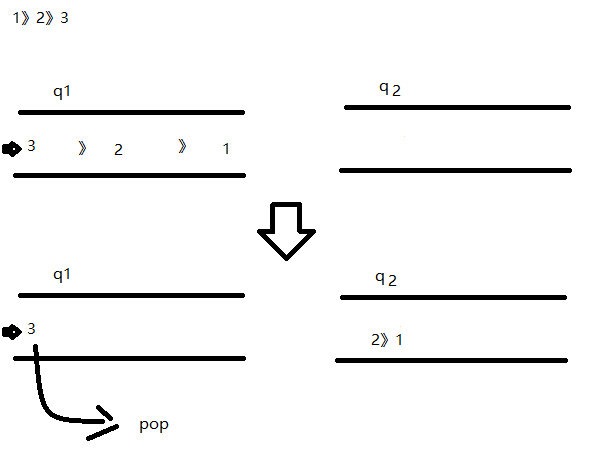使用佇列來模擬棧
阿新 • • 發佈:2018-12-08
使用佇列實現棧的下列操作:
- push(x) -- 元素 x 入棧
- pop() -- 移除棧頂元素
- top() -- 獲取棧頂元素
- empty() -- 返回棧是否為空
注意:
- 你只能使用佇列的基本操作-- 也就是 push to back, peek/pop from front, size, 和 is empty 這些操作是合法的。
- 你所使用的語言也許不支援佇列。 你可以使用 list 或者 deque(雙端佇列)來模擬一個佇列 , 只要是標準的佇列操作即可。
- 你可以假設所有操作都是有效的(例如, 對一個空的棧不會呼叫 pop 或者 top 操作)。
首先我們來看張圖:

我們先來模擬佇列的方法:
//構造佇列 type Queue struct { queue []int } func NewQueue() *Queue { return &Queue{[]int{}} } //將n放進佇列中 func (queue *Queue) Push(n int) { queue.queue = append(queue.queue, n) } //彈出最先進入佇列的值 func (queue *Queue) Pop() int { res := queue.queue[0] queue.queue= queue.queue[1:] return res } //檢視佇列的第一個元素 func (queue *Queue) Peek() int { res := queue.queue[0] return res } func (queue *Queue) Len() int { return len(queue.queue) }
那我們就來考慮如何來利用佇列來模擬棧了:
- push:對於push,我們只需要把所有元素都放進q1中就行
- pop:對於pop,當q1的長度為1的時候,直接pop,當不等於1的時候,我們就要把前n-1個元素放進q2中,然後pop q1的值,再把q1和q2調換
- top:對於top,其實與pop差不多,只是不減少元素而已
- empty:只需要比較q1和q2的元素和是不是等於0即可
package main import ( "fmt" ) type MyStack struct { q1, q2 *Queue } /** Initialize your data structure here. */ func Constructor() MyStack { stack := MyStack{&Queue{}, &Queue{}} return stack } /** Push element x onto stack. */ func (this *MyStack) Push(x int) { this.q1.Push(x) } /** Removes the element on top of the stack and returns that element. */ func (this *MyStack) Pop() int { if this.q1.Len() == 1 { return this.q1.Pop() } for this.q1.Len() > 1 { this.q2.Push(this.q1.Pop()) } res := this.q1.Pop() this.q1, this.q2 = this.q2, this.q1 return res } /** Get the top element. */ func (this *MyStack) Top() int { if this.q1.Len() == 1 { res := this.q1.Pop() this.q1.Push(res) return res } for this.q1.Len() > 1 { this.q2.Push(this.q1.Pop()) } res := this.q1.Pop() this.q2.Push(res) this.q1, this.q2 = this.q2, this.q1 return res } /** Returns whether the stack is empty. */ func (this *MyStack) Empty() bool { return this.q1.Len()+this.q2.Len() == 0 } //構造佇列 type Queue struct { queue []int } func NewQueue() *Queue { return &Queue{[]int{}} } //將n放進佇列中 func (queue *Queue) Push(n int) { queue.queue = append(queue.queue, n) } //彈出最先進入佇列的值 func (queue *Queue) Pop() int { res := queue.queue[0] queue.queue = queue.queue[1:] return res } //檢視佇列的第一個元素 func (queue *Queue) Peek() int { res := queue.queue[0] return res } func (queue *Queue) Len() int { return len(queue.queue) } func main() { stack := Constructor() stack.Push(1) stack.Push(2) fmt.Println(stack.Top()) fmt.Println(stack.Pop()) fmt.Println(stack.Top()) fmt.Println(stack.Pop()) fmt.Println(stack.Empty()) }
